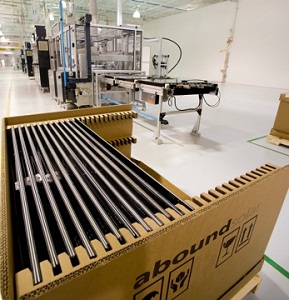A tour of Abound Solar's manufacturing plant, part 4
 Making the module conductive
Making the module conductive
This is the last step before moving to the second part of the manufacturing process.
“We still need to add a metallic layer to complete the semiconductor and finish off the electrical conductivity,” Weinstein said. The conductivity is added through a process of sputtering, she said. The panes pass through a series of white chambers where the panes are bombarded with Abound’s proprietary blend of metallic ingredients, making the module conductive.
After this process is complete, the pane is sandwiched with another piece of glass, and the sealing process begins, which protects the modules against water and vapor, according to Weinstein.
Water damage and vapor have ruined many photovoltaic panels throughout the years, which is why proper sealing is important.
After the panels are sealed, they’re run through a press to make sure everything is evenly distributed. They’re then run through a bath of saline and tested to ensure that the seal is intact.
Upon completion of the sealing process, the panels are nearly ready for shipping, save for one step.
“We test every module to see what the power output is, said Weinstein. “Then we’ll sticker it with that value.”
Since the company began production, the power of the modules has increased steadily. The first modules were in the 45-watt range, but in slightly more than a year, the wattage has jumped to 77.5 watts, which was reached in January 2011.
Though the company’s only been producing its panels for more than a year, it’s already enjoying a steady stream of business. As such, customers get the panels as they are manufactured.
“Because of the way our process happens, some will come out in the 67.5-watt range; some will come out as 72-watt modules. If a module comes out as a 72.7 watt module, we round down to the next lower bin so our customer is always going to get some upside. So if they purchase 72.5 watt modules, they’ll get anything between 72.5 watts and 74.9 watts.”
Abound’s modules are already being installed as far as away as Germany. They’re powering the first ever green Burger King in the world there, Weinstein said.
Looking forward, she said, “We do have a special focus on investing in the U.S., in terms of selling into this market. Unfortunately, the U.S. is a more difficult market to sell in than Germany or other countries with feed-in-tariffs. We definitely would like to have more of our product installed in the U.S. and, of course, in Colorado in particular.”



